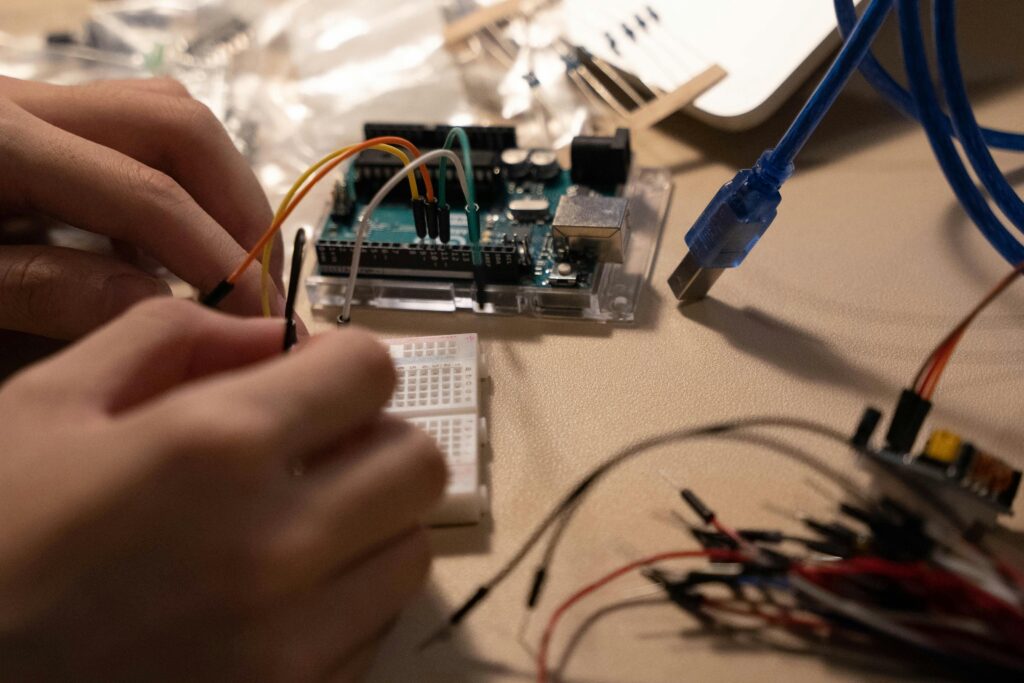Exploring Decentralized Finance (DeFi): The Future of Banking?
Understanding Decentralized Finance (DeFi): An Introduction

Understanding Decentralized Finance (DeFi): An Introduction
Decentralized Finance, commonly referred to as DeFi, has emerged as a captivating and revolutionary concept within the crypto industry. This innovative approach aims to transform traditional financial systems by removing intermediaries, such as banks or other centralized institutions, and instead leveraging blockchain technology for providing greater transparency, efficiency, and accessibility to financial services.
At its core, DeFi encompasses a wide array of financial applications and protocols built upon decentralized networks like Ethereum. It allows individuals to directly interact with these applications and engage in various financial activities such as lending, borrowing, trading, and investing – all without having to rely on the trust and involvement of third parties.
One of the key advantages of DeFi lies in its open-source nature. This means that anyone with an internet connection can participate in the DeFi ecosystem and access the services offered. Additionally, decentralized finance inherits the security features provided by blockchain technology. Transactions carried out on DeFi platforms are validated and recorded on a distributed ledger, making them tamper-proof and resistant to censorship or fraudulent activities.
Within the DeFi ecosystem, you will come across numerous applications that provide different services. Let’s explore some of the most common ones:
- Decentralized Exchanges (DEXs):
DEXs enable users to trade cryptocurrencies directly from their wallets without relying on a centralized exchange. These platforms employ smart contracts to facilitate peer-to-peer trading and offer users full custody of their digital assets. - Lending & Borrowing:
DeFi platforms also allow users to lend or borrow cryptocurrencies through smart contracts. By depositing their assets as collateral, users can access loans or earn interest by lending their idle funds. - Stablecoins:
Stablecoins are cryptocurrencies designed to maintain a stable value by pegging their prices to real-world assets or government-issued currencies. They offer stability amidst the volatility experienced by other cryptocurrencies and are widely used within the DeFi space. - Yield Farming:
Yield farming, also known as liquidity mining, involves providing liquidity to various DeFi platforms in exchange for rewards. By locking their funds into specific DeFi protocols, users can earn additional tokens or fees generated by the platform. - Decentralized Insurance:
DeFi insurance protocols provide coverage against potential risks and vulnerabilities within the ecosystem. These platforms enable users to protect their investments and safeguard against potential smart contract hacks or unwanted events.
The above examples merely scratch the surface of the vast possibilities offered by decentralized finance. Its ability to democratize access to financial services, eliminate intermediaries, and create new innovative solutions has had a profound impact on the world of crypto. As DeFi continues to evolve and attract more attention from investors, it is crucial to stay informed about the latest developments and potential risks associated with this emerging sector.
How DeFi is Changing the Face of Banking and Financial Services

Decentralized Finance, commonly known as DeFi, has emerged as a revolutionary force that is altering the landscape of traditional banking and financial services. With growing popularity in recent years, DeFi solutions leverage blockchain technology to provide users with a more inclusive, transparent, and accessible financial ecosystem. Let’s delve into the various aspects highlighting how DeFi is transforming the face of banking and financial services.
Firstly, DeFi overturns the conventional centralized model by focusing on decentralization, granting individuals full control over their financial assets. Rather than relying on intermediaries like banks or governments for transactions, smart contracts powered by blockchain enable direct peer-to-peer interactions. Through DeFi protocols, users can manage their own funds securely without surrendering control to third parties.
Additionally, DeFi introduces numerous financial instruments and services that were previously reserved for institutions or high net-worth individuals. It opens doors for anyone with an internet connection and a supported wallet to participate in activities such as borrowing loans, earning interest, trading cryptocurrencies, or providing liquidity in decentralized exchanges. This democratization allows for greater participation and inclusion in the financial system, especially for the unbanked or underbanked populations who have limited access to traditional banking infrastructure.
The concept of Yield Farming has gained significant attention within the DeFi ecosystem. This practice involves users providing liquidity to lending platforms or decentralized exchanges and receiving rewards in the form of additional digital tokens/coins. These incentives not only encourage user engagement but also enable individuals to earn passive income on their cryptocurrency holdings—an opportunity that was mostly monopolized by professional investors prior to DeFi’s emergence.
Moreover, one essential characteristic of DeFi is its interoperability. Unlike traditional financial systems fragmented by siloed databases and differing standards across institutions, DeFi protocols seamlessly interact with each other through open-source standards like EIP-20 (Ethereum Improvement Proposal 20). This interoperability empowers users to easily navigate across various DeFi applications (often referred to as decentralized apps or dApps), combining different services to suit their specific needs. For example, users can deposit their cryptocurrency as collateral in one dApp for a loan and then utilize the borrowed amount on another dApp for trading or funding other activities.
Another major advantage offered by DeFi is transparent and auditable transactions. Since every transaction recorded on the blockchain is publicly accessible, users can verify the integrity of funds movement at any point, mitigating concerns related to fraud or corrupted intermediaries. This transparency reinforces trust, which is crucial for wider adoption of financial systems and encourages innovation in areas such as micro-lending, peer-to-peer insurance, or asset tokenization.
Nonetheless, it’s important to acknowledge that while DeFi presents immense potential, it also faces challenges that need to be addressed. Smart contract vulnerabilities, such as coding bugs or security flaws, have resulted in significant financial losses for some users. Therefore, developers and auditors must continually strive to enhance smart contract security standards. Furthermore, issues like regulatory compliance and integrating traditional financial systems with these emerging technologies necessitate careful consideration.
In conclusion, DeFi stands as a disruptive force transforming the traditional banking and financial services landscape. It grants individuals autonomy, facilitates financial inclusivity, and introduces new opportunities through decentralized protocols that connect users in a transparent manner. As the DeFi ecosystem evolves, its impact will likely extend beyond the realms of finance, paving the way for novel innovations and reshaping various industries as blockchain technology continues to mature.
Exploring the Key Components of DeFi Ecosystems

Decentralized Finance, or DeFi, has taken the world of Cryptocurrency by storm. Unlike traditional financial systems that rely on intermediaries such as banks and insurance companies, DeFi aims to create a decentralized alternative where transactions are peer-to-peer and executed autonomously through smart contracts. To understand this rapidly evolving ecosystem, it is crucial to explore its key components.
- Smart Contracts: At the heart of every DeFi ecosystem lies smart contracts, which are self-executing contracts with the terms of agreements written into code. These contracts automatically facilitate, verify, and enforce transactions without any centralized authority involved. They eliminate intermediaries, reducing costs and enhancing security.
- Decentralized Exchanges (DEXs): Traditional exchanges require users to trust centralized entities to handle their assets and trades. In contrast, DEXs enable direct peer-to-peer cryptocurrency trading without any intermediary control over funds. They achieve this by utilizing smart contracts to match buyers and sellers securely and implement trades transparently.
- Stablecoins: Volatility has long been recognized as a major obstacle for mainstream adoption of cryptocurrencies. Stablecoins, commonly pegged to established assets like fiat currency or commodities, offer stability by reducing price swings associated with other cryptocurrencies. By using smart contracts and blockchain technology, stablecoins allow users to hold and transact in relatively stable digital assets.
- Lending and Borrowing: Similar to traditional financial systems but without relying on banks, DeFi platforms enable users to lend or borrow digital assets directly from one another using smart contracts. This opens up new possibilities for both borrowers seeking loans without credit checks and lenders looking for better returns on their investments.
- Yield Farming: Yield farming involves boosting returns on crypto assets by leveraging various DeFi protocols effectively. By allocating funds strategically across different lending platforms or liquidity pools, users can earn additional profits denominated in the native tokens of these platforms through APR (Annual Percentage Rate) rewards, governance tokens, or other incentives.
- Decentralized Insurance: While decentralized systems promote security and trustlessness, they are not immune to risks or vulnerabilities. To address these concerns, DeFi platforms are exploring the integration of decentralized insurance protocols. These protocols aim to protect users against potential hacks, contract failures, and other scenarios that could result in financial loss.
- Governance Mechanisms: As DeFi ecosystems evolve, they require robust governance mechanisms to ensure their sustainability and development. Governance tokens enable individuals who hold them to actively participate in shaping the ecosystem’s future by voting on key protocol upgrades, suggesting new features, proposing changes in parameter settings, or even contributing development efforts.
- Interoperability: DeFi is not limited to a single blockchain or protocol; instead, it thrives on interoperability between various blockchain networks. Interoperability allows the seamless exchange of assets and functions across multiple platforms and blockchains, enhancing liquidity and expanding possibilities for users operating in heterogeneous DeFi ecosystems.
Exploring these fundamental components of DeFi ecosystems reveals the innovative power distributed ledgers and smart contracts possess. The allure lies in the potential for disrupting traditional finance, redistributing power from centralized authorities to individuals worldwide seeking financial sovereignty while optimizing privacy and security. However, it is important to acknowledge ongoing challenges such as scalability, user experience, and regulatory frameworks that must be addressed as DeFi continues its rapid growth trajectory in the Crypto Market.
The Rise of DeFi: Analyzing Growth Trends and Future Projections

The rise of decentralized finance (DeFi) has been a prominent trend in the crypto market that is capturing the attention of investors and enthusiasts alike. DeFi refers to a new breed of financial applications that are built on blockchain networks, providing users with decentralized and transparent access to a wide range of financial services.
The growth trends surrounding DeFi have been remarkable, with the total value locked (TVL) in DeFi protocols experiencing substantial growth over the past few years. Starting from minuscule amounts, the TVL in DeFi now stands at billions of dollars. This substantial increase indicates a growing interest in DeFi and an expanding user base.
One prominent driver behind the rise of DeFi is its potential for disrupting traditional financial systems. By leveraging blockchain technology and smart contracts, DeFi eliminates the need for intermediaries such as banks or central authorities in various financial transactions. This disintermediation allows for permissionless access and has the potential to democratize financial services globally.
DeFi also offers a plethora of financial services previously limited to traditional banking systems, including lending and borrowing, trading, yield farming, insurance, and more. These services are accessible by anyone with an internet connection, creating opportunities for individuals who are underserved or excluded by existing financial institutions.
One crucial aspect of DeFi’s growth is the concept of liquidity mining or yield farming. Investors provide funds to DeFi protocols and are rewarded with native tokens or other incentives. This mechanism attracts users to lock their assets into DeFi protocols, thereby increasing their TVL. It has proven to be an effective strategy for bootstrapping liquidity and cultivating communities around new projects.
However, the rise of DeFi hasn’t been without challenges. Security vulnerabilities and smart contract flaws have resulted in instances of hacking and significant financial losses for some users. Proper auditing and code reviews are essential to minimize such risks. Regulatory frameworks also pose challenges for DeFi, as governments grapple with addressing its decentralized and cross-border nature.
Looking ahead, DeFi’s future projections appear promising. The ongoing development of layer 2 scaling solutions, such as Ethereum’s implementation of ETH 2.0, aims to address scalability issues and reduce transaction costs in DeFi applications. These improvements will likely attract more users and bolster the overall growth of DeFi.
Additionally, advancements in interoperability standards and cross-chain solutions may further enhance DeFi’s potential by connecting different blockchain networks. The ability to transfer assets seamlessly between different protocols would create a more connected and efficient DeFi ecosystem.
It is important to note that the fast-paced nature of the crypto market makes specific projection timelines precarious. However, it seems increasingly plausible that DeFi will continue its trajectory of growth and play a significant role in shaping the future of finance.
DeFi vs. Traditional Banking: Pros, Cons, and Potential Impacts

Decentralized finance (DeFi) and traditional banking have been placed side by side as alternative approaches to financial systems, with each having its own set of pros, cons, and potential impacts. Let’s dive deeper into understanding these aspects without the hindrance of numbered lists.
DeFi essentially represents a concept where financial applications are built using blockchain technology. This eliminates the need for intermediaries such as banks, enabling peer-to-peer financial interactions on a global scale. Contrarily, traditional banking comprises the tried-and-true system most people are accustomed to, encompassing well-established financial institutions regulated by governments and central banks.
Starting with the advantages of DeFi, proponents believe that it eliminates the role of intermediaries, leading to reduced fees and transaction costs. As transactions occur directly between parties involved, there is no need for additional overhead expenses often associated with traditional banking services. Furthermore, DeFi aims to prioritize financial inclusivity, granting access to individuals who may not have access to traditional services due to geographical or socio-economic limitations.
On the other hand, traditional banking retains several vital features that many consider pros. Primarily, traditional banking systems offer stability and trust rooted in long-standing regulations and governmental backing. These institutions adhere to Know Your Customer (KYC) norms and Anti-Money Laundering (AML) regulations, which ensure transparent financial operations and reduce the risk of illicit activities. Additionally, traditional banks provide services like customer support, dispute resolution mechanisms, and easy access to fiat currencies.
For all its advantages, DeFi does come with a few challenges that can be perceived as cons. Firstly, due to its evolutionary nature, DeFi lacks sufficient regulatory oversight relative to its traditional counterpart. This makes it susceptible to scams or Ponzi schemes disguised as legitimate projects. Additionally, decentralized networks still face scalability challenges and latency issues caused by congested blockchain networks like Ethereum. This means that the user experience may sometimes be compromised when using DeFi platforms.
To analyze the potential impacts, it’s fair to say that DeFi has done a commendable job in piquing public interest and attracting users who value financial sovereignty and innovative blockchain technologies. Its potential to remove the need for intermediaries has even sparked discussions regarding the future of centralized banking itself. However, it is important to recognize that DeFi is not an outright replacement for traditional banking but rather an alternative model that can coexist alongside it.
Going forward, traditional banks have begun exploring opportunities within the realm of DeFi. Collaborations, research initiatives, and piloting new digital financial services are notable cases where traditional institutions strive to exploit this foray while leveraging their existing infrastructure and customer base.
In conclusion, the underlying idea behind DeFi is undeniably intriguing and disruptive. By bypassing intermediaries and increasing accessibility, it has the potential to democratize finance on a global scale. Nevertheless, issues concerning regulation, scalability, and security still require ironing out. As both systems evolve in parallel, a collaborative approach might be the key to unlock a financial ecosystem where the best aspects of both DeFi and traditional banking can coexist harmoniously, catering to versatile user needs.
The Role of Smart Contracts in Decentralized Finance

Smart contracts are an integral aspect of decentralized finance (DeFi), playing a significant role in revolutionizing the traditional financial ecosystem. Built on blockchain technology, smart contracts facilitate trustless and automated transactions, empowering individuals to hold control over their financial assets without the need for intermediaries. These digital agreements eliminate the necessity of manual enforcement and offer secure and transparent mechanisms to enforce contractual obligations.
One of the primary benefits of smart contracts in DeFi is their ability to automate financial services. Through predefined precepts and programmable logic, smart contracts can execute customized actions based on trigger events or specific conditions. This automation expedites the processing of transactions, reduces human errors, and eliminates the need for intermediaries, thereby reducing costs associated with traditional centralized financial services.
Moreover, smart contracts enhance financial inclusivity. Traditional banking systems consistently fail to provide open accessibility to financial services. However, decentralized finance leveraging smart contract technology bridges this gap by enabling individuals globally to access various financial tools such as lending, borrowing, staking, yield farming, insurance, and others. Smart contracts operate on a permissionless network, ensuring that anyone with an internet connection can participate in DeFi without requiring any intermediary’s approval.
By eliminating centralized regulations and costly intermediaries like banks or insurance companies, DeFi powered by smart contracts enables users to retain greater control over their funds. Utilizing blockchain technology ensures full transparency of transactions as they are recorded on a public ledger accessible to anyone. This transparency promotes trust and accountability within the financial ecosystem.
In addition, smart contracts facilitate composability in DeFi protocols. The modular structure of these programmable agreements allows developers to create interoperable applications that can seamlessly interact with each other, amplifying the range and options available for users. Developers can leverage existing protocols by building new layers or add-ons, thus sorting multiple functionalities into a single user-friendly platform.
However, it is crucial to understand that smart contracts are not entirely infallible. Their code is created by human developers and might contain bugs or vulnerabilities that could be exploited. Incidents such as the well-known “DAO hack” exemplify how these inherent risks can lead to loss of funds or data breaches. Therefore, smart contract audits are significant to ensure code security before deploying them. Efforts to enhance security practices and formal verification tools are continuously being undertaken to mitigate these risks.
Overall, the role of smart contracts in decentralized finance is fundamental, unlocking endless possibilities for individuals to access a range of financial services trustlessly and transparently. These programmable agreements empower users, reduce reliance on intermediaries, automate processes, and drive financial inclusion while acknowledging the importance of security. Continued advances in this space will undoubtedly redefine the traditional financial industry for years to come.
Security in DeFi: Challenges and Solutions for a Safer Environment

Security in DeFi, decentralized finance, is a critical concern given the increasing popularity of this innovative financial ecosystem. While DeFi brings numerous advantages such as permissionless access and greater financial inclusion, it also introduces various challenges that need to be addressed for the creation of a safer environment.
First and foremost, one of the notable challenges in DeFi security lies within smart contract vulnerabilities. Smart contracts power most DeFi apps and execute financial transactions without intermediaries. However, even small coding errors or flaws within these contracts can be exploited by attackers. Auditing and thoroughly testing smart contracts are vital measures to minimize such risks.
Moreover, the prevalence of phishing attacks poses significant dangers in the DeFi space. Bad actors utilize various tactics to deceive and trick users into revealing their private keys or providing sensitive information. Enhanced user education on best security practices, coupled with clear warnings of potential phishing attempts, become paramount in ensuring a safer environment for participants.
The risk associated with price manipulation is another obstacle requiring attention. The scope for market manipulation can arise when the liquidity of a particular DeFi market is limited. By conducting large trades, bad actors can induce substantial price swings known as flash crashes, causing immense losses to investors. Implementing stricter regulations and transparency regarding liquidity levels can mitigate this risk.
Additionally, oracle attacks also pose a challenge in DeFi security. Oracles provide external data inputs to smart contracts making crucial decisions in DeFi protocols. Manipulating the data that these oracles feed into the system leads to incorrect actions being taken by the smart contract, allowing hackers to exploit vulnerabilities and execute fraudulent transactions. Developing reliable decentralized oracle networks and encouraging multiple source verification greatly enhances the security mechanisms utilized by DeFi platforms.
Furthermore, centralization within DeFi systems serves as a vulnerability as well. Many projects within the space rely on centralized control for decision-making and key infrastructure services. This dependency undermines the fundamental aspects of decentralization and creates single points of failure. Advancing towards more decentralized governance models and infrastructure design can minimize the risks associated with centralized control.
Finally, addressing the challenge of asset theft is of utmost importance in DeFi security. Hackers often exploit vulnerabilities in platforms and protocols to gain unauthorized access and loose user funds. Adding additional layers of security, such as multi-signature wallets or utilizing hardware wallets, provides increased protection to users’ assets.
All of these challenges require comprehensive solutions to create a safer environment in DeFi. Continuous auditing and rigorous testing practices for smart contracts are critical. User education and raising awareness about potential risks like phishing attacks are essential. Building decentralized oracle networks and minimizing centralization also play vital roles in bolstering security. Instituting regulations and transparency regarding liquidity levels can prevent market manipulation, while implementing layer security measures fortifies defenses against asset theft.
For a thriving decentralized finance ecosystem that provides users with trust, security is an ongoing process that must continuously adapt to emerging threats and challenges.
Navigating the Regulatory Landscape of DeFi Globally

The regulatory landscape of decentralized finance (DeFi) presents a complex web of rules and regulations that vary across different countries around the world. Navigating these regulations is crucial for individuals and companies involved in the DeFi ecosystem to ensure compliance and avoid potential legal issues.
Firstly, it’s important to acknowledge that DeFi platforms offer financial services beyond traditional borders, making them subject to regulations in multiple jurisdictions. As such, understanding the applicable laws in each region is essential. Keep in mind that there may be unique requirements based on local legislation and regulatory bodies.
In some countries, DeFi activities operate in a gray area due to the absence of explicit regulations tailored to this emerging sector. Nevertheless, recent developments have shown an increasing interest from authorities worldwide, highlighting the significance of proactive compliance efforts by DeFi projects.
Regulatory considerations often revolve around three major aspects: securities laws, anti-money laundering (AML) and know-your-customer (KYC) measures, and consumer protection. Securities laws focus on determining whether certain tokens or activities fall under regulatory definitions as securities, which may necessitate adherence to specific disclosure and registration requirements.
To tackle AML and KYC concerns, many jurisdictions expect verification procedures to ensure compliant identification and discourage illegal activities. These requirements aim to enhance transparency within DeFi platforms by minimizing risks associated with money laundering, terrorism financing, and other illicit behavior. Additionally, these regulations may demand record-keeping obligations for platforms engaging in large-scale financial transactions.
Consumer protection is another focal point for regulators globally. The risk inherent in DeFi protocols places significant responsibility on users in terms of understanding potential vulnerabilities and ensuring secure practices. Governments are more likely to intervene if proof of fraudulent or exploitative activities emerges, aiming to safeguard individuals from financial harm.
Given the global nature of DeFi, projects need to adopt a multifaceted approach when navigating diverse regulatory landscapes. Engaging legal counsel with expertise in various jurisdictions can provide invaluable guidance on the compliance framework authorities expect. Collaborating with blockchain industry associations can also be beneficial in monitoring regulatory changes or joining conversations to influence policy decisions.
Moreover, forging strong partnerships within the broader financial ecosystem such as banks or other regulated entities can help bridge DeFi with traditional finance, satisfying some regulatory requirements and fostering legitimacy.
Lastly, engaging in open dialogues and actively collaborating with regulators can assist in shaping regulations that are conducive to DeFi’s growth while balancing risk reduction objectives. By proactively working towards creating a regulatory framework that embraces innovation, DeFi projects stand a higher chance of avoiding potential crackdowns or overly burdensome regulation.
In conclusion, navigating the regulatory landscape of DeFi globally demands diligent research, constant monitoring of developments, and proactive compliance measures. While challenges persist due to varying regulations across jurisdictions, embracing transparency, and seeking legal counsel are integral to maintain legitimacy and foster long-term success.
The Top DeFi Platforms of the Year: Features and Innovations

Decentralized Finance (DeFi) has emerged as one of the most transformative sectors in the crypto market. As 2021 comes to an end, it’s crucial to explore the top DeFi platforms that have introduced groundbreaking features and innovations. These platforms enable individuals to engage in various financial activities without relying on intermediaries. Here, we’ll delve into some of the leading DeFi protocols that have made waves this year.
- Uniswap: Uniswap holds a prominent position among decentralized exchanges (DEXs). By utilizing automated market-making (AMM), it allows users to trade cryptocurrencies directly from their wallets. The platform offers liquidity pools where users can provide their funds and earn fees by facilitating trades.
- Aave: Aave is renowned for pioneering the concept of lending and borrowing in the DeFi space. Users can lend their assets and earn passive income through interest rates, while borrowers can access loans by collateralizing their cryptocurrencies. The protocol also features flash loans, which enable users to borrow funds without posting collateral, as long as the loan is repaid within a single transaction block.
- Compound: Similar to Aave, Compound offers lending and borrowing services through a transparent and autonomous lending protocol. Users can supply their digital assets as collateral or borrow against them while generating interest on deposited funds.
- MakerDAO: MakerDAO provides users with a decentralized stablecoin called DAI by locking Ethereum-based assets as collateral. The platform enables individuals to generate DAI loans, effectively unlocking liquidity while maintaining exposure to the assets locked as collateral.
- Synthetix: This protocol allows users to create synthetic assets that mirror the value of real-world assets. Synthetic tokens track prices of various commodities, fiat currencies, stocks, or even cryptocurrencies not natively available on blockchain networks.
- Yearn.finance: Yearn.finance is an innovative yield aggregator platform that optimizes yield farming by automating the process of shifting funds between different lending protocols to maximize returns. Users can deposit their assets, and the algorithm automatically allocates them to the best opportunities within the DeFi ecosystem.
- SushiSwap: SushiSwap is a decentralized exchange built on top of Uniswap. It introduces advanced features and governance tokens that provide rewards, voting rights, and decision-making power to liquidity providers and token holders.
- Balancer: Balancer operates as an automated portfolio manager, allowing users to create customizable liquidity pools with multiple tokens and varied weights rather than a fixed pairing. These pools offer lower slippage for trades compared to traditional exchanges.
- Curve Finance: Curve Finance stands out as a specialized DEX focused on stablecoin trading. The protocol aims to provide low-slippage swaps between stablecoins by concentrating liquidity in its pools, ensuring better efficiency for stablecoin trades.
These are just a few of the top DeFi platforms that have excelled in presenting innovative features throughout this year. Each platform caters to different user needs, including lending and borrowing, decentralized trading, yield farming, synthetics creation, and optimizing token management. Together, they contribute significantly to the rapidly expanding DeFi space, revolutionizing how we interact with traditional financial services.
Lending and Borrowing in the DeFi Space: How It Works and What to Know

Lending and borrowing in the DeFi (Decentralized Finance) space have emerged as key components of the thriving crypto market. DeFi lending platforms act as intermediaries, allowing users to lend or borrow digital assets without the requirement of a traditional financial institution. This relatively new and innovative process has gained significant attention due to its decentralized nature, transparency, and potential for generating high returns.
Let’s delve into how lending and borrowing work within the DeFi space.
- Supplying Assets:
By supplying crypto assets to a lending platform, individuals effectively become lenders. They lock their digital currency into a smart contract and earn interest over time by lending it to other users or protocols operating on the platform. These platforms typically support several cryptocurrencies such as Ethereum (ETH), stablecoins like Tether (USDT), or specific tokens developed on top of blockchain networks. - Earn Yield:
Lenders earn additional income through annual percentage yield (APY) or interest rates offered by borrowers. Generally, the interests are set algorithmically based on supply and demand dynamics within the platform. Due to decentralized governance mechanisms, these lending platforms reduce interference from centralized organizations when determining interest rates. - Collateralization:
On the borrowing side, individuals can utilize their digital assets as collateral to secure loans. Borrowers lock crypto holdings into smart contracts, providing assurance that they are committed to repaying the funds over a specified period. This collateralization process helps eliminate unnecessary interventions from traditional credit checks and factors in assessing loan eligibility. - Loan Agreements:
Borrowers request funds by submitting loan proposals adhering to specific terms and conditions denoting loan details like requested amount, interest rate, and repayment duration. Lenders can review these proposals and choose to fund them partially or entirely based on their preferences. Once approved, borrowers can access the loaned assets transferred to their wallets. - Overcollateralization:
To counteract potential risks of default, DeFi lending platforms impose overcollateralization requirements. Borrowers often need to provide more than 100% worth of the borrowed amount as collateral, safeguarding the lender’s investment in case of a sudden drop in collateral value. - Automation and Smart Contracts:
DeFi lending platforms use smart contracts, enabling autonomous execution of lending and borrowing operations based on predetermined conditions. This approach offers reliability, eliminates intermediaries, reduces costs, and increases efficiency by automating the various steps involved. - Risk Factors:
Although DeFi lending opens doors to opportunity, it also presents some risks. Market volatility affects the collateral value, placing borrowers at risk of liquidation if their collateral falls below a specified threshold ratio. Moreover, user error or malicious actions can expose vulnerabilities in smart contracts, resulting in security concerns.
To enter the world of lending and borrowing in DeFi, users should consider several factors like interest rates, collateral requirements, terms and conditions, platform security audits, and stability when choosing a platform best aligned with their investment goals.
Overall, DeFi lending and borrowing empower individuals by offering an alternative financial system that is accessible to anyone globally. The enticing potential for profitable returns has spurred substantial innovation within the crypto market while challenging traditional centralized financial institutions. Monitoring this space closely for new developments poses exciting opportunities for investors seeking exposure to decentralized finance.
Yield Farming and Liquidity Mining: A Deep Dive into DeFi Earning Mechanics

Yield Farming and Liquidity Mining: A Deep Dive into DeFi Earning Mechanics
In the ever-evolving world of decentralized finance (DeFi), two buzzwords that have garnered significant attention are “yield farming” and “liquidity mining.” Both of these concepts aim to provide users with avenues to earn returns by participating in various DeFi protocols and lending platforms. Let’s take a closer look at these exciting earning mechanics in the world of cryptocurrency.
Yield Farming:
Yield farming, also known as liquidity mining, is a strategy that allows investors to earn additional tokens by lending or staking their crypto assets on decentralized platforms. The foundational principle behind yield farming relies on offering liquidity to DeFi protocols. By deploying their digital assets into these platforms, yield farmers enable other users to trade and access these assets more easily. In return for providing liquidity, yield farmers receive rewards in the form of additional tokens from these protocols. These rewards often come in the same or another cryptocurrency, fostering excitement around potential gains.
How Does Yield Farming Work?
Yield farmers usually take part in decentralized exchanges (DEXs) or lending protocols. They first deposit their idle assets into suitable liquidity pools established by such platforms. These pools require a balance of various tokens to run effectively. By contributing to this pool imbalance, the yield farmer ensures its smooth operations while earning lucrative rewards for their participation.
To leverage yield farming optimally, farmers often move between different decentralized finance projects constantly—chasing higher yields as opportunities arise. This fast-paced approach is popular due to potential high returns but simultaneously presents risks and complexities associated with gas fees, market fluctuations, or vulnerable smart contract codes.
Liquidity Mining:
Liquidity mining is a specific subset of yield farming that revolves around incentivizing users to contribute liquidity by adding their holdings to pools with good volume and utilization rates. Usually integrated with decentralized exchanges, these protocols reward liquidity providers with tokens proportional to their share in the total liquidity pool. By ensuring a more robust and fluid marketplace, liquidity mining aims to function as a win-win situation for both providers and users alike.
One crucial consideration in liquidity mining is the concept of impermanent loss, wherein the value of tokens in a liquidity pool can undergo irregular fluctuations compared to if they were held individually. Liquidity providers should understand this risk and weigh it against the potential rewards before deciding to participate actively.
Conclusion:
In summary, yield farming and liquidity mining form incentive-based mechanisms within the DeFi ecosystem, allowing cryptocurrency holders to participate actively in earning income from their assets. However, it’s vital to approach these practices with proper caution due to the ever-changing landscape of DeFi, associated risks, and complexities ranging from smart contract security to market volatility. As with any investment-related activity, it’s advisable to conduct thorough research and consider expert opinion before engaging in yield farming or liquidity mining activities in the crypto market.
Tokenomics in DeFi: Understanding Tokens and Governance Models

Tokenomics is the combination of the words “token” and “economics,” representing the economic system associated with digital tokens and their properties within a blockchain ecosystem. In decentralized finance (DeFi), tokenomics refers to the design and implementation of tokens as well as their role in governing various aspects of the decentralized protocols.
Tokens in DeFi are digital assets built on blockchain platforms like Ethereum. These tokens serve a wide range of purposes, such as facilitating transactions, representing ownership or voting rights, or granting access to specific functionalities within a DeFi protocol. They can be broadly categorized into four types: governance tokens, utility tokens, payment tokens, and security tokens.
Governance tokens give holders the power to influence decision-making within the protocol. These tokens are deployed for decentralized autonomous organizations (DAOs) and allow token holders to participate in the governance process by voting on proposals like protocol upgrades, fees, incentive structures, or changes to underlying rules. Users holding these tokens have a say in shaping the future direction of a specific DeFi project.
Utility tokens grant certain utilities or access rights within a platform. These tokens enable users to utilize particular services offered by a protocol, such as staking, lending, borrowing, yield farming, or accessing specific features. Holding utility tokens can entitle users to benefits like reduced fees, enhanced functionalities, or additional rewards within the corresponding DeFi platform.
Payment tokens are primarily used for transactional purposes within the DeFi ecosystem. They function as a medium of exchange for goods and services. In DeFi platforms, payment tokens offer seamless and cost-effective methods of transferring value between different parties without relying on traditional financial intermediaries.
Security tokens represent underlying securities or assets like traditional stocks, bonds, real estate properties, art pieces, or commodities. They are actively regulated by authorities and are subject to strict legal compliance. However, their application within DeFi is relatively limited due to compliance complexities associated with security laws.
Tokenomics within DeFi includes several governance models for managing and distributing tokens. Some projects employ “fair launch” mechanisms, where tokens are issued directly to users through processes like airdrops or yield farming incentives to ensure broad token distribution. Other protocols feature vesting schedules that gradually release tokens, as a measure against market manipulation or long-term alignment with project goals.
Tokenomics also plays a vital role in incentivizing network participants. By employing mechanisms such as staking or liquidity mining, DeFi protocols reward users who provide liquidity, stake tokens for governance, or secure the network. Such incentivization promotes the growth and sustainability of the ecosystem.
In conclusion, tokenomics is a crucial aspect of DeFi that encompasses the design, distribution, and governance of tokens within blockchain-based protocols. It aids in creating decentralized systems that effectively allocate resources, enable user participation, and foster sustainable growth within the crypto market ecosystem.
Privacy Concerns in Decentralized Finance: Issues and Emerging Solutions

Privacy Concerns in Decentralized Finance: Issues and Emerging Solutions
Decentralized Finance (DeFi) has surged in popularity as an innovative and revolutionary concept that allows individuals to have control over their financial assets while bypassing intermediaries such as banks. While this brings numerous advantages, it also raises concerns, particularly regarding users’ privacy and data security. The advent of blockchain technology enables censorship-resistant and transparent transactions, but it inherently compromises privacy due to its public nature. This article will explore the privacy concerns in DeFi and delve into emerging solutions to address these issues.
- Linking Real-world Transactions with Public Addresses:
One critical concern revolves around the pseudonymous nature of blockchain transactions, where user identities may be determined by linking their real-world actions with their public wallet addresses. This linkage poses a significant risk of compromising individuals’ privacy and revealing sensitive financial information, leading to potential exploitation. - Transparent Transaction Information:
Blockchain transactions are accessible to everyone, providing complete transparency on activity details, including transaction amounts and the involved parties. While this transparency is beneficial for verifying transactions’ authenticity, it becomes problematic when privacy expectations conflict with the need for transparency. - Inadequate Privacy Protection Tools:
In traditional finance, individuals could rely on bank secrecy laws or established privacy measures. However, with DeFi’s decentralized nature, these tools are generally absent or insufficient. Thus, innovation is essential to address these gaps and ensure a level of privacy that satisfies users. - On-chain Data Analysis:
With blockchain’s immutable nature, all transactional information remains permanently stored on the network making them susceptible to analysis by third parties without requiring consent. Such analysis can lead to profiling users or identifying illicit activities.
To address these privacy concerns, several emerging solutions are being developed within the realm of DeFi:
- Privacy-oriented Blockchains:
Privacy-focused blockchains provide a solution by leveraging cryptographic techniques and algorithms to obfuscate transactional information. These blockchains, such as Monero and Zcash, employ advanced cryptographic protocols to enhance privacy while still preserving the decentralized nature of DeFi. - Zero-Knowledge Proofs:
Zero-knowledge proofs (ZKPs) enable proving the validity of certain statements without revealing any underlying information. In DeFi, ZKPs can be used to verify transactional details without disclosing sensitive data, offering a balance between transparency and privacy. - Off-Chain Privacy Solutions:
Off-chain privacy solutions leverage technologies like secure multi-party computation (sMPC) or trusted execution environments (TEEs) to perform complex computations off-chain, ensuring that sensitive data remains private while only providing the necessary information publicly. - Decentralized Identity Solutions:
Decentralized identity systems offer users control over their personal data and identity. By using self-sovereign identity frameworks, individuals can authenticate themselves privately while interacting with DeFi platforms, minimizing the risk of exposing real-world identities associated with public addresses.
Conclusion:
As decentralized finance expands further, addressing privacy concerns becomes paramount for its sustainability and mass adoption. The decentralized nature of blockchain technology indeed creates challenges in safeguarding user privacy. However, emerging solutions like privacy-oriented blockchains, zero-knowledge proofs, off-chain privacy solutions, and decentralized identity systems provide promising avenues to mitigate these concerns and secure user data in DeFi transactions. It is crucial for the DeFi community to embrace and implement these solutions to ensure that individuals can enjoy the benefits of financial freedom while preserving their privacy rights.
The Environmental Impact of DeFi Operations: A Critical Analysis

The Environmental Impact of DeFi Operations: A Critical Analysis
The rise of decentralized finance (DeFi) in recent years has undoubtedly created new opportunities for financial inclusion and innovation. However, it is crucial to examine the environmental consequences of DeFi operations amidst growing concerns over the sustainability of cryptocurrency networks.
First and foremost, the environmental impact of DeFi operations largely stems from the energy consumption associated with blockchain infrastructure. Cryptocurrencies like Bitcoin and Ethereum rely on a consensus algorithm called proof-of-work (PoW), which relies heavily on computational power and energy consumption. Consequently, mining activities demand vast amounts of electricity, chiefly sourced from fossil fuel-based power plants.
Furthermore, the scalable nature of DeFi applications has led to a surge in network congestion, expanding their energy requirements even further. The computation needed for validating transactions and executing smart contracts consumes immense volumes of energy, contributing to the carbon footprint associated with DeFi networks.
Another factor to consider is the e-waste generated from the mining equipment used in DeFi operations. As graphics processing units (GPUs) and specialized mining rigs become obsolete due to technological advancements or increased mining difficulty, they contribute to electronic waste that often ends up in landfills or improper disposal sites. Such e-waste not only poses long-term environmental hazards but also requires energy for proper recycling.
Moreover, as crypto prices increase, there is an incentive for miners to mine more intensively, leading to even higher energy consumption and subsequent environmental implications. The ongoing demand for newer and more efficient hardware exacerbates this trend while putting additional pressure on global supply chains.
However, it should be noted that not all DeFi projects utilize PoW-based cryptocurrencies. Some blockchain networks like Ethereum 2.0 and other emerging alternatives are transitioning towards more eco-friendly consensus algorithms such as proof-of-stake (PoS). PoS relies on participants holding a stake in the network, significantly reducing energy requirements compared to PoW. This shift could help mitigate the environmental impact of DeFi operations in the future.
Furthermore, developers and DeFi protocols are increasingly exploring alternative energy sources to power their operations. Initiatives focusing on using renewable energy, carbon offsetting programs, and other sustainable practices are emerging within the DeFi space. These initiatives aim to counterbalance some of the environmental concerns by reducing the carbon emissions associated with cryptocurrencies.
Overall, the environmental impact of DeFi operations is a critical aspect that needs further exploration and consideration. While undeniable challenges persist in terms of high energy consumption, e-waste, and carbon emissions associated with certain cryptocurrencies, the industry’s potential to innovate and adopt greener alternatives offers hope for a more sustainable future.
Bridging the Gap: Making DeFi Accessible to Traditional Bank Users

DeFi, or decentralized finance, has been making waves in the crypto world by revolutionizing financial services and removing intermediaries. It enables individuals to access banking and financial tools without needing a traditional bank. However, despite its promising potential, DeFi has primarily been confined within the crypto sphere, limiting its reach to traditional bank users who may not be familiar with cryptocurrencies or blockchain technology.
To bridge this glaring gap and open up DeFi to a broader audience, various innovative solutions have emerged. One such solution is simplifying the user experience through user-friendly interfaces and intuitive platforms that resemble traditional banking applications. By designing interfaces similar to what people are accustomed to, traditional bank users can readily adopt DeFi without feeling overwhelmed or confused.
Additionally, educating users is vital in making DeFi accessible. Many traditional bank users may be unfamiliar with foundational concepts like blockchain, smart contracts, or decentralized applications (DApps). Consequently, there is a need for educational content, tutorials, and explainer videos that break down complex terms and concepts, helping traditional bank users understand the underlying technology and benefits of DeFi.
Interoperability between traditional banks and DeFi protocols plays another critical role in accessibility. One way to achieve this is by integrating traditional banking services into DeFi platforms. This integration can provide users with seamless connectivity between their existing bank accounts and DeFi applications, allowing them to transact in both traditional and crypto assets effortlessly.
Furthermore, partnerships between established financial institutions and decentralized platforms could act as bridges. Mainstream banks can collaborate with reputable DeFi projects to offer their customers more extensive access to DeFi products and services approved by regulatory requirements. This cooperative approach helps reduce stigma and instill trust among traditional bank users considering DeFi investments.
To encourage adoption by traditional bank users, it is also essential to tackle concerns over security and regulation. As the cryptocurrency market has experienced various scams and frauds in the past, implementing robust security measures becomes paramount. Developing well-audited smart contracts, conducting regular security audits, and researching potential risks can alleviate user concerns.
Moreover, regulatory clarity is crucial for traditional bank users to confidently embrace DeFi. Governments and regulatory bodies need to establish clear guidelines around DeFi operations to prevent misuse and provide users with legal protections. With proper regulation in place, traditional bank users are more likely to perceive DeFi as a safe and legitimate financial option.
Lastly, fostering an ecosystem of trust and established reputations helps bridge the gap. Platforms that promote transparency, community governance, and active user support facilitate a sense of trust amongst traditional bank users when transitioning into DeFi. Genuine reviews, testimonials, and case studies shared by early adopters can help alleviate initial skepticism.
Overall, bridging the gap between DeFi and traditional bank users requires a multi-faceted approach. From user-friendly interfaces and educational resources to enhanced interoperability, security measures, regulatory clarity, partnerships with mainstream institutions, and building a trusting ecosystem – each component contributes significantly to making DeFi accessible to those more accustomed to traditional banking systems. As these efforts combine forces on various fronts, it has the potential to democratize finance worldwide by empowering individuals who were previously excluded from the financial system.

